Curriculum Learning Framework for Fault Diagnosis in Electric Motor Systems Based on Recurrent Neural Networks
Abstract
1. Introduction
1.1. Fault Diagnosis of Electric Motors
1.2. Generalisation to Extrapolated Operating Conditions
1.3. Contributions
2. Related Works
2.1. Concept of Curriculum Learning and Applications
2.2. Curriculum Learning Methods
2.2.1. Predefined CL
2.2.2. Automatic CL
2.3. Previous Work
3. CL Strategy Proposed
3.1. Problem Formulation
3.2. Dataset
3.3. Complexity Measurer
3.4. Training Scheduler
3.5. Methodology
3.5.1. Pre-Processing
| Algorithm 1: ReSVD-CL Algorithm |
|
| Algorithm 2: ReSVD-CLNet Algorithm |
|
3.5.2. Training Process
3.6. Management Loop for Loss of Information
4. Experiments and Testing Results
4.1. Training Performances
4.2. Testing Performances
4.3. Influence of the Difficulty Measurer
5. Comparison with Existing Regimens
5.1. One-Pass CL
5.2. Baby-Step CL
5.3. Baseline Approaches
6. Results and Discussions
6.1. Results
6.2. Discussions
7. Conclusions
Author Contributions
Funding
Data Availability Statement
Conflicts of Interest
References
- Liu, G.; Shen, W.; Gao, L.; Kusiak, A. Predictive modeling with an adaptive unsupervised broad transfer algorithm. IEEE Trans. Instrum. Meas. 2021, 70, 1–12. [Google Scholar] [CrossRef]
- Luo, S.; Huang, X.; Wang, Y.; Luo, R.; Zhou, Q. Transfer learning based on improved stacked autoencoder for bearing fault diagnosis. Knowl.-Based Syst. 2022, 256, 109846. [Google Scholar] [CrossRef]
- Zhu, Z.; Lei, Y.; Qi, G.; Chai, Y.; Mazur, N.; An, Y.; Huang, X. A review of the application of deep learning in intelligent fault diagnosis of rotating machinery. Measurement 2023, 206, 112346. [Google Scholar] [CrossRef]
- Eren, L.; Ince, T.; Kiranyaz, S. A generic intelligent bearing fault diagnosis system using compact adaptive 1D CNN classifier. J. Signal Process. Syst. 2019, 91, 179–189. [Google Scholar] [CrossRef]
- Schwendemann, S.; Amjad, Z.; Sikora, A. Bearing fault diagnosis with intermediate domain based layered maximum mean discrepancy: A new transfer learning approach. Eng. Appl. Artif. Intell. 2021, 105, 104415. [Google Scholar] [CrossRef]
- Asutkar, S.; Tallur, S. Deep transfer learning strategy for efficient domain generalisation in machine fault diagnosis. Sci. Rep. 2023, 13, 6607. [Google Scholar] [CrossRef] [PubMed]
- Estrada-Flores, S.; Merts, I.; De Ketelaere, B.; Lammertyn, J. Development and validation of “grey-box” models for refrigeration applications: A review of key concepts. Int. J. Refrig. 2006, 29, 931–946. [Google Scholar] [CrossRef]
- Rajulapati, L.; Chinta, S.; Shyamala, B.; Rengaswamy, R. Integration of machine learning and first principles models. AIChE J. 2022, 68, e17715. [Google Scholar] [CrossRef]
- Zendehboudi, S.; Rezaei, N.; Lohi, A. Applications of hybrid models in chemical, petroleum, and energy systems: A systematic review. Appl. Energy 2018, 228, 2539–2566. [Google Scholar] [CrossRef]
- Quiza, R.; López-Armas, O.; Davim, J.P. Hybrid Modeling and Optimization of Manufacturing: Combining Artificial Intelligence and Finite Element Method; Springer Science & Business Media: Berlin/Heidelberg, Germany, 2012. [Google Scholar]
- Sun, W.; Yan, R.; Jin, R.; Zhao, R.; Chen, Z. Curriculum-Based Federated Learning for Machine Fault Diagnosis with Noisy Labels. IEEE Trans. Ind. Inform. 2024, 20, 13820–13830. [Google Scholar] [CrossRef]
- Zhang, K.; Wang, B.; Zheng, Q.; Ding, G.; Ma, J.; Tang, B. A novel fault diagnosis of high-speed train axle box bearings with adaptive curriculum self-paced learning under noisy labels. Struct. Health Monit. 2025. [Google Scholar] [CrossRef]
- Lai, P.; Zhang, F.; Li, T.; Guo, J.; Teng, F.; Liu, R. A Curriculum-Based Meta-Learning Approach for Few-Shot Fault Diagnosis. In Proceedings of the 2023 3rd International Conference on Digital Society and Intelligent Systems (DSInS), Chengdu, China, 10–12 November 2023; IEEE: Piscataway, NJ, USA, 2023; pp. 224–229. [Google Scholar]
- Wang, Z.; Xuan, J.; Shi, T. Multi-label fault recognition framework using deep reinforcement learning and curriculum learning mechanism. Adv. Eng. Inform. 2022, 54, 101773. [Google Scholar] [CrossRef]
- de Las Morenas, J.; Moya-Fernández, F.; López-Gómez, J.A. The edge application of machine learning techniques for fault diagnosis in electrical machines. Sensors 2023, 23, 2649. [Google Scholar] [CrossRef]
- Alwodai, A.; Gu, F.; Ball, A. A comparison of different techniques for induction motor rotor fault diagnosis. J. Physics Conf. Ser. 2012, 364, 012066. [Google Scholar] [CrossRef]
- Jigyasu, R.; Sharma, A.; Mathew, L.; Chatterji, S. A review of condition monitoring and fault diagnosis methods for induction motor. In Proceedings of the 2018 Second International Conference on Intelligent Computing and Control Systems (ICICCS), Madurai, India, 14–15 June 2018; IEEE: Piscataway, NJ, USA, 2018; pp. 1713–1721. [Google Scholar]
- Mallioris, P.; Aivazidou, E.; Bechtsis, D. Predictive maintenance in Industry 4.0: A systematic multi-sector mapping. CIRP J. Manuf. Sci. Technol. 2024, 50, 80–103. [Google Scholar] [CrossRef]
- Morhain, A.; Mba, D. Bearing defect diagnosis and acoustic emission. Inst. Mech. Eng. Part J. Eng. Tribol. 2003, 217, 257–272. [Google Scholar] [CrossRef]
- Al-Ghamd, A.M.; Mba, D. A comparative experimental study on the use of acoustic emission and vibration analysis for bearing defect identification and estimation of defect size. Mech. Syst. Signal Process. 2006, 20, 1537–1571. [Google Scholar] [CrossRef]
- Li, C.J.; Li, S. Acoustic emission analysis for bearing condition monitoring. Wear 1995, 185, 67–74. [Google Scholar] [CrossRef]
- Tandon, N.; Yadava, G.; Ramakrishna, K. A comparison of some condition monitoring techniques for the detection of defect in induction motor ball bearings. Mech. Syst. Signal Process. 2007, 21, 244–256. [Google Scholar] [CrossRef]
- Govardhan, T.; Choudhury, A.; Paliwal, D. Vibration analysis of a rolling element bearing with localized defect under dynamic radial load. J. Vib. Eng. Technol. 2017, 5, 165–175. [Google Scholar]
- Fontes, A.S.; Cardoso, C.A.; Oliveira, L.P. Comparison of techniques based on current signature analysis to fault detection and diagnosis in induction electrical motors. In Proceedings of the 2016 Electrical Engineering Conference (EECon), Colombo, Sri Lanka, 15 December 2016; IEEE: Piscataway, NJ, USA, 2016; pp. 74–79. [Google Scholar]
- Junior, R.F.R.; dos Santos Areias, I.A.; Gomes, G.F. Fault detection and diagnosis using vibration signal analysis in frequency domain for electric motors considering different real fault types. Sens. Rev. 2021, 41, 311–319. [Google Scholar] [CrossRef]
- Tahmasbi, D.; Shirali, H.; Souq, S.S.M.N.; Eslampanah, M. Diagnosis and root cause analysis of bearing failure using vibration analysis techniques. Eng. Fail. Anal. 2024, 158, 107954. [Google Scholar] [CrossRef]
- Fatima, S.; Mohanty, A.; Kazmi, H. Fault classification and detection in a rotor bearing rig. J. Vib. Eng. Technol. 2016, 4, 491–498. [Google Scholar]
- Li, H.; Zhang, Y. Bearing faults diagnosis based on EMD and Wigner-Ville distribution. In Proceedings of the 2006 6th World Congress on Intelligent Control and Automation, Dalian, China, 21–23 June 2006; IEEE: Piscataway, NJ, USA, 2006; Volume 2, pp. 5447–5451. [Google Scholar]
- Kankar, P.K.; Sharma, S.C.; Harsha, S.P. Rolling element bearing fault diagnosis using wavelet transform. Neurocomputing 2011, 74, 1638–1645. [Google Scholar] [CrossRef]
- Sunal, C.E.; Dyo, V.; Velisavljevic, V. Review of machine learning based fault detection for centrifugal pump induction motors. IEEE Access 2022, 10, 71344–71355. [Google Scholar] [CrossRef]
- Gundewar, S.K.; Kane, P.V. Condition monitoring and fault diagnosis of induction motor. J. Vib. Eng. Technol. 2021, 9, 643–674. [Google Scholar] [CrossRef]
- Lee, D.; Siu, V.; Cruz, R.; Yetman, C. Convolutional neural net and bearing fault analysis. In Proceedings of the International Conference on Data Science (ICDATA), The Steering Committee of The World Congress in Computer Science, Computer Engineering and Applied Computing (WorldComp), Bordeaux, France, 2016; p. 194. Available online: https://worldcomp-proceedings.com/proc/p2016/DMI8005.pdf (accessed on 14 October 2025).
- Kiral, Z.; Yigit, A.; GÜRSES, B. Analysis of rolling element bearing faults via curve length transform. J. Vib. Eng. Technol. 2014, 2. [Google Scholar]
- Patidar, S.; Soni, P.K. An overview on vibration analysis techniques for the diagnosis of rolling element bearing faults. Int. J. Eng. Trends Technol. (IJETT) 2013, 4, 1804–1809. [Google Scholar]
- Mohd Ghazali, M.H.; Rahiman, W. Vibration analysis for machine monitoring and diagnosis: A systematic review. Shock Vib. 2021, 2021, 9469318. [Google Scholar] [CrossRef]
- Tama, B.A.; Vania, M.; Lee, S.; Lim, S. Recent advances in the application of deep learning for fault diagnosis of rotating machinery using vibration signals. Artif. Intell. Rev. 2023, 56, 4667–4709. [Google Scholar] [CrossRef]
- Akbar, S.; Vaimann, T.; Asad, B.; Kallaste, A.; Sardar, M.U.; Kudelina, K. State-of-the-art techniques for fault diagnosis in electrical machines: Advancements and future directions. Energies 2023, 16, 6345. [Google Scholar] [CrossRef]
- Antonino-Daviu, J.A.; Zamudio-Ramirez, I.; Osornio-Rios, R.A.; Dunai, L. Fault diagnosis in electric motors through the analysis of currents and stray fluxes. In Proceedings of the 2023 International Conference on Electromechanical and Energy Systems (SIELMEN), Craiova, Romania, 11–13 October 2023; IEEE: Piscataway, NJ, USA, 2023; pp. 1–7. [Google Scholar]
- Wang, J.; Li, Y.; Gao, R.X.; Zhang, F. Hybrid physics-based and data-driven models for smart manufacturing: Modelling, simulation, and explainability. J. Manuf. Syst. 2022, 63, 381–391. [Google Scholar] [CrossRef]
- Hanachi, H.; Yu, W.; Kim, I.Y.; Liu, J.; Mechefske, C.K. Hybrid data-driven physics-based model fusion framework for tool wear prediction. Int. J. Adv. Manuf. Technol. 2019, 101, 2861–2872. [Google Scholar] [CrossRef]
- Bhutani, N.; Rangaiah, G.P.; Ray, A.K. First-principles, data-based, and hybrid modeling and optimization of an industrial hydrocracking unit. Ind. Eng. Chem. Res. 2006, 45, 7807–7816. [Google Scholar] [CrossRef]
- Guo, F.; Li, A.; Yue, B.; Xiao, Z.; Xiao, F.; Yan, R.; Li, A.; Lv, Y.; Su, B. Improving the out-of-sample generalization ability of data-driven chiller performance models using physics-guided neural network. Appl. Energy 2024, 354, 122190. [Google Scholar] [CrossRef]
- Huang, S.; Qin, H.; Hou, W.; Zhang, X.; Zhang, X. Generalizable Physics-Guided Convolutional Neural Network for Irregular Terrain Propagation. IEEE Trans. Antennas Propag. 2025, 73, 3975–3985. [Google Scholar] [CrossRef]
- Gallup, E.; Gallup, T.; Powell, K. Physics-guided neural networks with engineering domain knowledge for hybrid process modeling. Comput. Chem. Eng. 2023, 170, 108111. [Google Scholar] [CrossRef]
- Li, Q.; Li, X.; Chen, X.; Yao, W. PEGNN: A physics embedded graph neural network for out-of-distribution temperature field reconstruction. Int. J. Therm. Sci. 2025, 207, 109393. [Google Scholar] [CrossRef]
- Elhamod, M.; Bu, J.; Singh, C.; Redell, M.; Ghosh, A.; Podolskiy, V.; Lee, W.C.; Karpatne, A. CoPhy-PGNN: Learning physics-guided neural networks with competing loss functions for solving eigenvalue problems. ACM Trans. Intell. Syst. Technol. 2022, 13, 1–23. [Google Scholar] [CrossRef]
- Suhas, M.; Abisset-Chavanne, E.; Rey, P.A. Cooperative Hybrid Modelling and Dimensionality Reduction for a Failure Monitoring Application in Industrial Systems. Sensors 2025, 25, 1952. [Google Scholar] [CrossRef]
- Yao, D.; Liu, H.; Yang, J.; Li, X. A lightweight neural network with strong robustness for bearing fault diagnosis. Measurement 2020, 159, 107756. [Google Scholar] [CrossRef]
- Selfridge, O.G.; Sutton, R.S.; Barto, A.G. Training and Tracking in Robotics. In Proceedings of the IJCAI, Los Angeles, CA, USA, 18–23 August 1985; pp. 670–672. [Google Scholar]
- Elman, J.L. Learning and development in neural networks: The importance of starting small. Cognition 1993, 48, 71–99. [Google Scholar] [CrossRef]
- Bengio, Y.; Louradour, J.; Collobert, R.; Weston, J. Curriculum learning. In Proceedings of the 26th Annual International Conference on Machine Learning, Montreal, QC, Canada, 14–18 June 2009; pp. 41–48. [Google Scholar]
- Wang, Y.; Gao, J.; Wang, W.; Yang, X.; Du, J. Curriculum learning-based domain generalization for cross-domain fault diagnosis with category shift. Mech. Syst. Signal Process. 2024, 212, 111295. [Google Scholar] [CrossRef]
- Pathak, H.N.; Paffenroth, R. Parameter continuation methods for the optimization of deep neural networks. In Proceedings of the 2019 18th IEEE International Conference On Machine Learning And Applications (ICMLA), Boca Raton, FL, USA, 16–19 December 2019; IEEE: Piscataway, NJ, USA, 2019; pp. 1637–1643. [Google Scholar]
- Wang, L.; Xu, Z.; Stone, P.; Xiao, X. Grounded curriculum learning. arXiv 2024, arXiv:2409.19816. [Google Scholar] [CrossRef]
- Gupta, K.; Mukherjee, D.; Najjaran, H. Extending the capabilities of reinforcement learning through curriculum: A review of methods and applications. SN Comput. Sci. 2022, 3, 1–18. [Google Scholar] [CrossRef]
- Yin, Y.; Chen, Z.; Liu, G.; Yin, J.; Guo, J. Autonomous navigation of mobile robots in unknown environments using off-policy reinforcement learning with curriculum learning. Expert Syst. Appl. 2024, 247, 123202. [Google Scholar] [CrossRef]
- Gao, X.; Yang, Y.; Peng, D.; Li, S.; Tan, C.; Li, F.; Chen, T. Graph Pointer Network Based Hierarchical Curriculum Reinforcement Learning Method Solving Shuttle Tankers Scheduling Problem. Complex Syst. Model. Simul. 2024, 4, 339–352. [Google Scholar] [CrossRef]
- Saglietti, L.; Mannelli, S.; Saxe, A. An analytical theory of curriculum learning in teacher-student networks. In Advances in Neural Information Processing Systems; MIT Press: Cambridge, MA, USA, 2022; Volume 35, pp. 21113–21127. [Google Scholar]
- Soviany, P.; Ionescu, R.T.; Rota, P.; Sebe, N. Curriculum Learning: A Survey. Int. J. Comput. Vis. 2022, 130, 1526–1565. [Google Scholar] [CrossRef]
- Wang, X.; Chen, Y.; Zhu, W. A Survey on Curriculum Learning. arXiv 2020. [Google Scholar] [CrossRef]
- Shi, T.; Wu, Y.; Song, L.; Zhou, T.; Zhao, J. Efficient reinforcement finetuning via adaptive curriculum learning. arXiv 2025, arXiv:2504.05520. [Google Scholar] [CrossRef]
- Zhou, S.; Wang, J.; Meng, D.; Xin, X.; Li, Y.; Gong, Y.; Zheng, N. Deep self-paced learning for person re-identification. Pattern Recognit. 2018, 76, 739–751. [Google Scholar] [CrossRef]
- Sangineto, E.; Nabi, M.; Culibrk, D.; Sebe, N. Self paced deep learning for weakly supervised object detection. IEEE Trans. Pattern Anal. Mach. Intell. 2018, 41, 712–725. [Google Scholar] [CrossRef]
- Platanios, E.A.; Stretcu, O.; Neubig, G.; Poczos, B.; Mitchell, T.M. Competence-based curriculum learning for neural machine translation. arXiv 2019, arXiv:1903.09848. [Google Scholar] [CrossRef]
- Kumar, G.; Foster, G.; Cherry, C.; Krikun, M. Reinforcement learning based curriculum optimization for neural machine translation. arXiv 2019, arXiv:1903.00041. [Google Scholar] [CrossRef]
- Doan, T.; Monteiro, J.; Albuquerque, I.; Mazoure, B.; Durand, A.; Pineau, J.; Hjelm, R.D. On-line adaptative curriculum learning for gans. In Proceedings of the AAAI Conference on Artificial Intelligence, Honolulu, HI, USA, 27 January–1 February 2019; Volume 33, pp. 3470–3477. [Google Scholar]
- Soviany, P.; Ardei, C.; Ionescu, R.T.; Leordeanu, M. Image difficulty curriculum for generative adversarial networks (CuGAN). In Proceedings of the IEEE/CVF Winter Conference on Applications of Computer Vision, Snowmass Village, CO, USA, 1–5 March 2020; pp. 3463–3472. [Google Scholar]
- Koenecke, A.; Gajewar, A. Curriculum Learning in Deep Neural Networks for Financial Forecasting. arXiv 2019. [Google Scholar] [CrossRef]
- Bucci, M.A.; Semeraro, O.; Allauzen, A.; Chibbaro, S.; Mathelin, L. Curriculum learning for data-driven modeling of dynamical systems. Eur. Phys. J. E 2023, 46, 12. [Google Scholar] [CrossRef] [PubMed]
- Sun, C.; Li, H.; Song, M.; Cai, D.; Zhang, B.; Hong, S. Adaptive model training strategy for continuous classification of time series. Appl. Intell. 2023, 53, 18821–18839. [Google Scholar] [CrossRef]
- Chen, X.; Gupta, A. Webly supervised learning of convolutional networks. In Proceedings of the IEEE International Conference on Computer Vision, Santiago, Chile, 7–13 December 2015; pp. 1431–1439. [Google Scholar]
- Portelas, R.; Colas, C.; Weng, L.; Hofmann, K.; Oudeyer, P.Y. Automatic curriculum learning for deep rl: A short survey. arXiv 2020, arXiv:2003.04664. [Google Scholar] [CrossRef]
- Tullis, J.G.; Benjamin, A.S. On the effectiveness of self-paced learning. J. Mem. Lang. 2011, 64, 109–118. [Google Scholar] [CrossRef]
- Kumar, M.; Packer, B.; Koller, D. Self-paced learning for latent variable models. In Advances in Neural Information Processing Systems; MIT Press: Cambridge, MA, USA, 2010; Volume 23, Available online: https://proceedings.neurips.cc/paper_files/paper/2010/file/e57c6b956a6521b28495f2886ca0977a-Paper.pdf (accessed on 14 October 2025).
- Matiisen, T.; Oliver, A.; Cohen, T.; Schulman, J. Teacher–student curriculum learning. IEEE Trans. Neural Netw. Learn. Syst. 2019, 31, 3732–3740. [Google Scholar] [CrossRef]
- Hacohen, G.; Weinshall, D. On the power of curriculum learning in training deep networks. In Proceedings of the International Conference on Machine Learning, Long Beach, CA, USA, 9–15 June 2019; PMLR: New York, NY, USA, 2019; pp. 2535–2544. [Google Scholar]
- Xu, B.; Zhang, L.; Mao, Z.; Wang, Q.; Xie, H.; Zhang, Y. Curriculum learning for natural language understanding. In Proceedings of the 58th Annual Meeting of the Association for Computational Linguistics, Online, 5–10 July 2020; pp. 6095–6104. [Google Scholar]
- Zhao, M.; Wu, H.; Niu, D.; Wang, X. Reinforced curriculum learning on pre-trained neural machine translation models. In Proceedings of the AAAI Conference on Artificial Intelligence, New York, NY, USA, 7–12 February 2020; Volume 34, pp. 9652–9659. [Google Scholar]
- Graves, A.; Bellemare, M.G.; Menick, J.; Munos, R.; Kavukcuoglu, K. Automated curriculum learning for neural networks. In Proceedings of the International Conference on Machine Learning, Sydney, Australia, 6–11 August 2017; PMLR: New York, NY, USA, 2017; pp. 1311–1320. [Google Scholar]
- Kocmi, T.; Bojar, O. Curriculum learning and minibatch bucketing in neural machine translation. arXiv 2017, arXiv:1707.09533. [Google Scholar] [CrossRef]
- Moon, T.K.; Stirling, W.C. Mathematical Methods and Algorithms for Signal Processing. Prentice Hall: Upper Saddle River, NJ, USA, 2000. [Google Scholar]
- Yang, K.; Shahabi, C. A PCA-Based Similarity Measure for Multivariate Time Series; Association for Computing Machinery: New York, NY, USA, 2004; pp. 65–74. [Google Scholar] [CrossRef]
- Spitkovsky, V.I.; Alshawi, H.; Jurafsky, D. From baby steps to leapfrog: How “less is more” in unsupervised dependency parsing. In Proceedings of the Human Language Technologies: The 2010 Annual Conference of the North American Chapter of the Association for Computational Linguistics, Los Angeles, CA, USA, 2–4June 2010; pp. 751–759. [Google Scholar]
- Cirik, V.; Hovy, E.; Morency, L.P. Visualizing and Understanding Curriculum Learning for Long Short-Term Memory Networks. arXiv 2016, arXiv:1611.06204. [Google Scholar] [CrossRef]
- Liu, H.; Ma, R.; Li, D.; Yan, L.; Ma, Z. Machinery fault diagnosis based on deep learning for time series analysis and knowledge graphs. J. Signal Process. Syst. 2021, 93, 1433–1455. [Google Scholar] [CrossRef]
- Zhang, G.; Li, Y.; Zhao, Y. A novel fault diagnosis method for wind turbine based on adaptive multivariate time-series convolutional network using SCADA data. Adv. Eng. Inform. 2023, 57, 102031. [Google Scholar] [CrossRef]
- Huang, T.; Zhang, Q.; Tang, X.; Zhao, S.; Lu, X. A novel fault diagnosis method based on CNN and LSTM and its application in fault diagnosis for complex systems. Artif. Intell. Rev. 2022, 55, 1289–1315. [Google Scholar] [CrossRef]
- Wang, T.; Huang, Z.; Sun, Z.; Xi, G. Reconstruction of natural convection within an enclosure using deep neural network. Int. J. Heat Mass Transf. 2021, 164, 120626. [Google Scholar] [CrossRef]

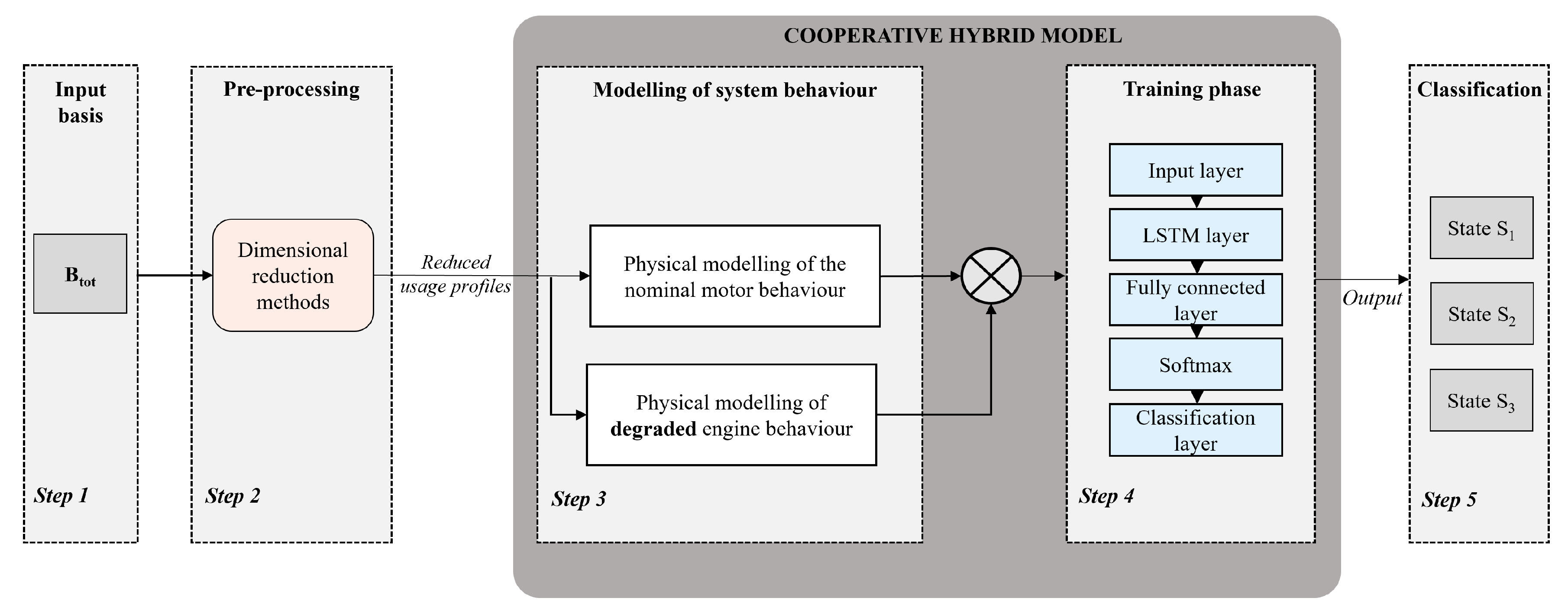
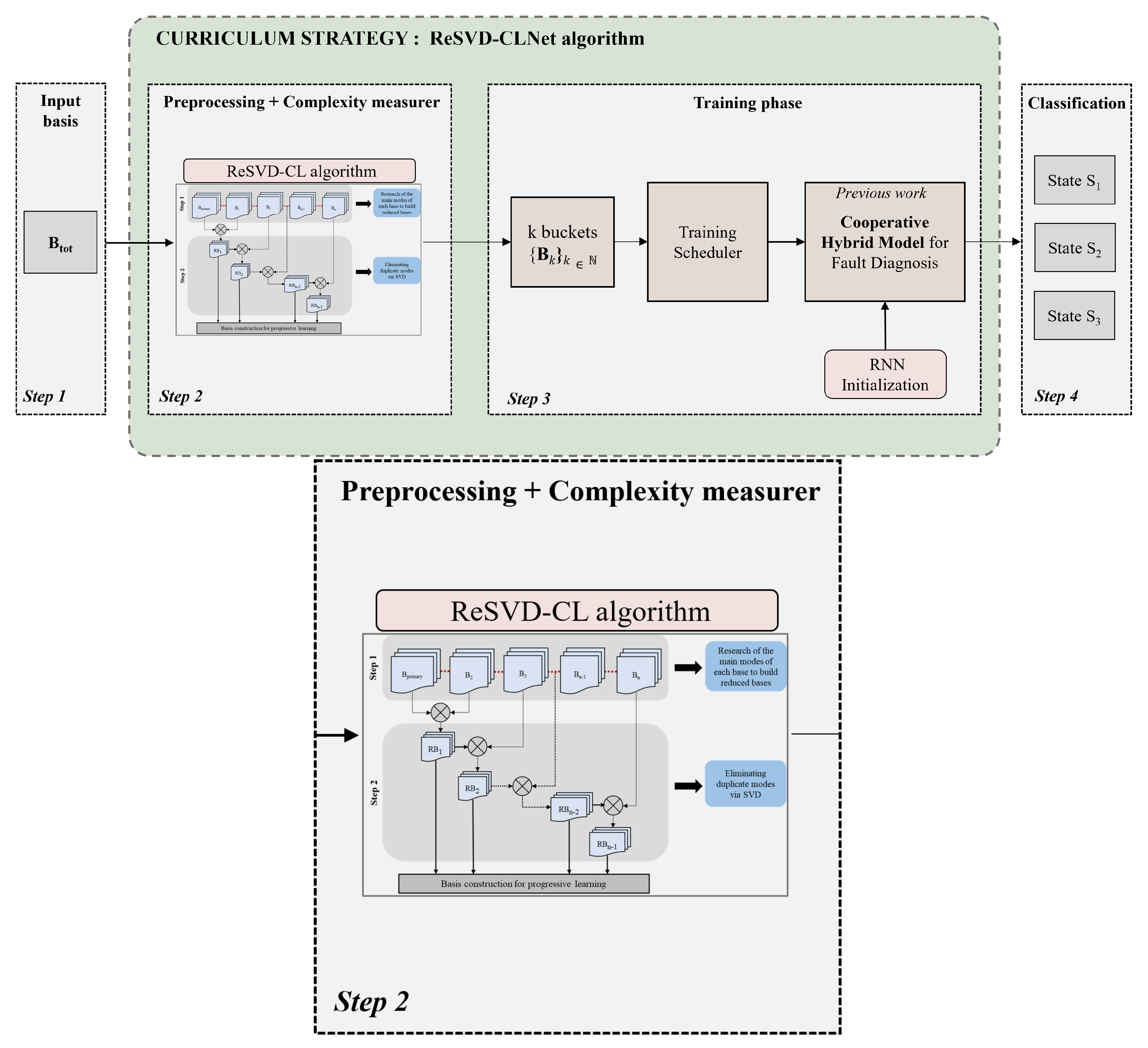
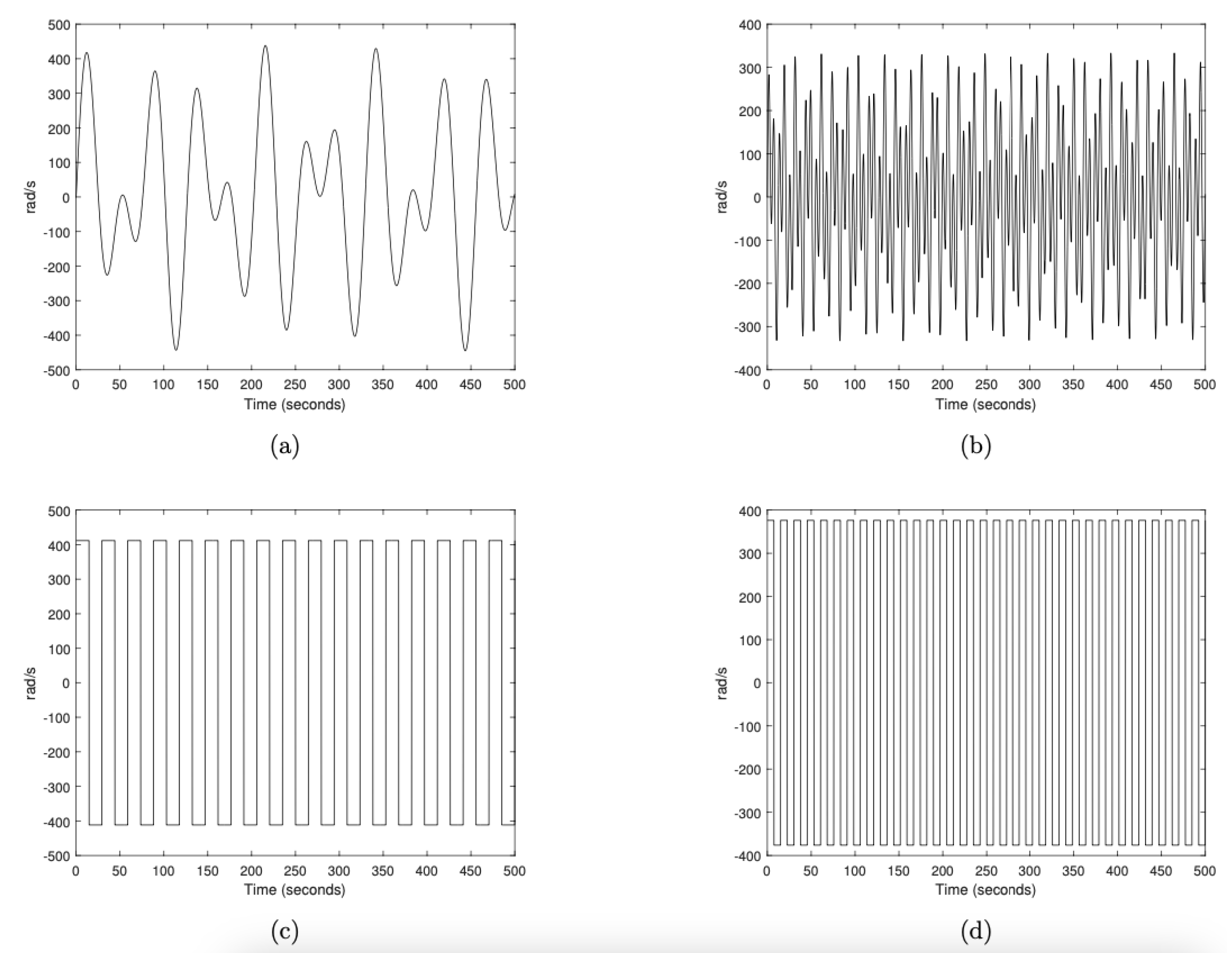

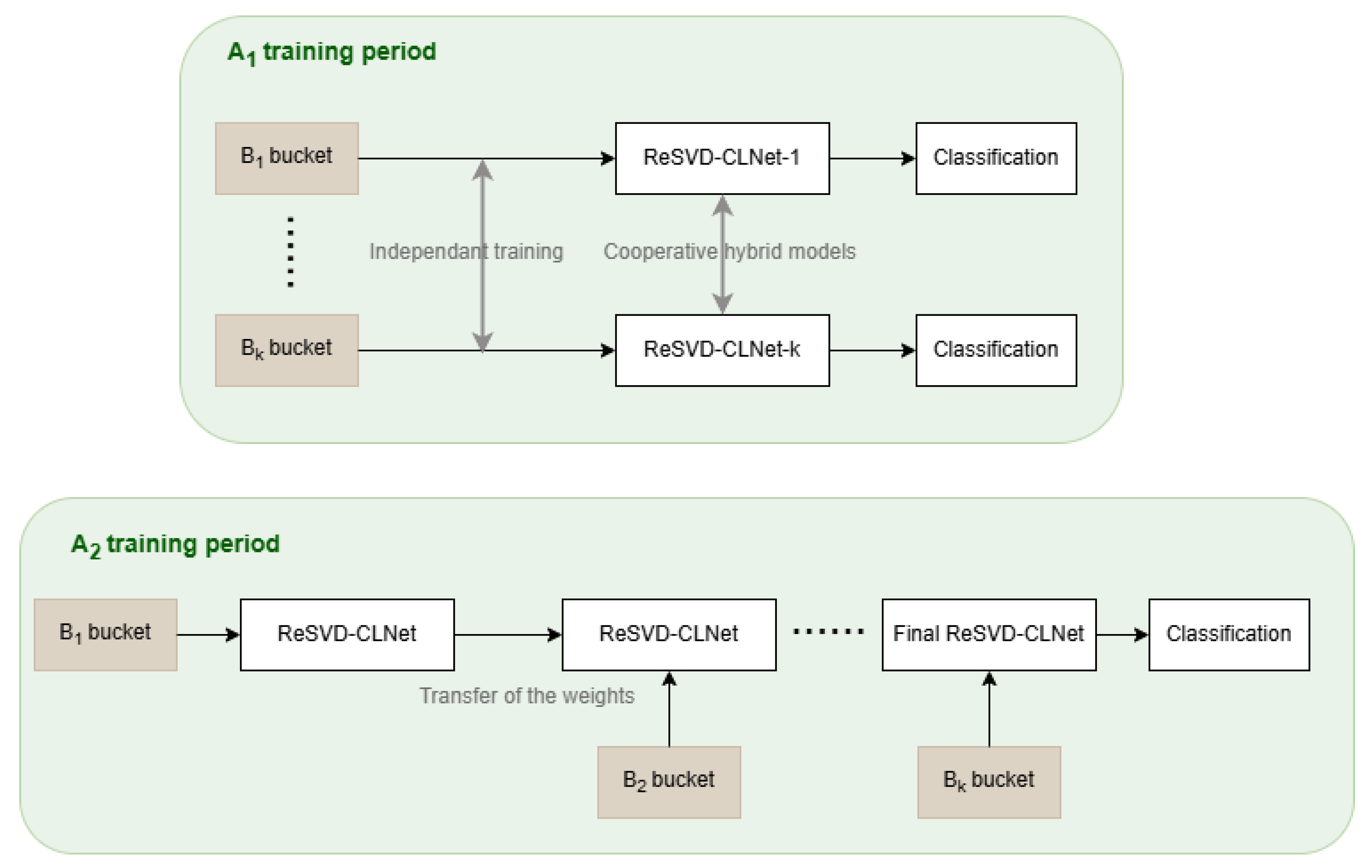
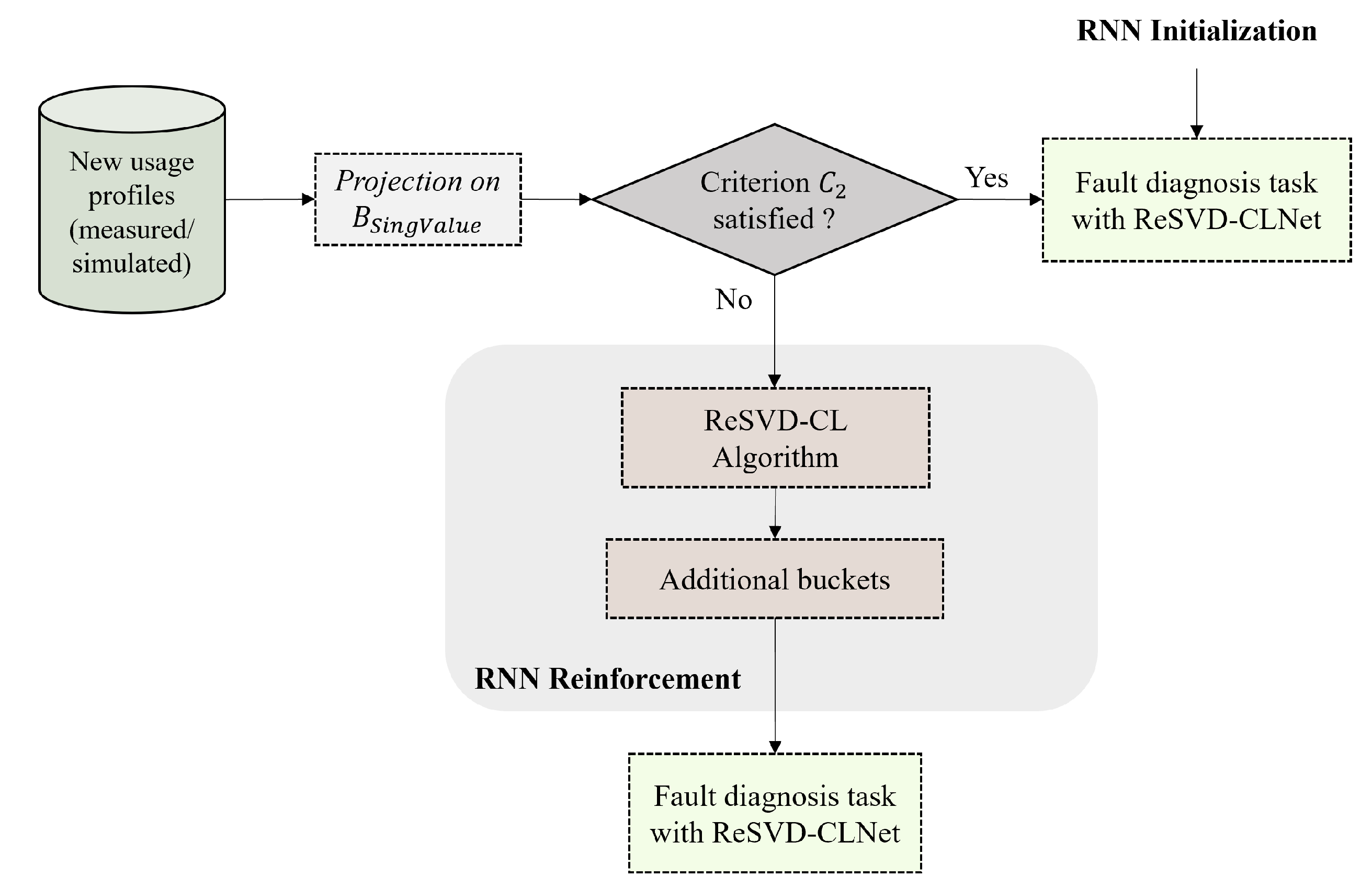
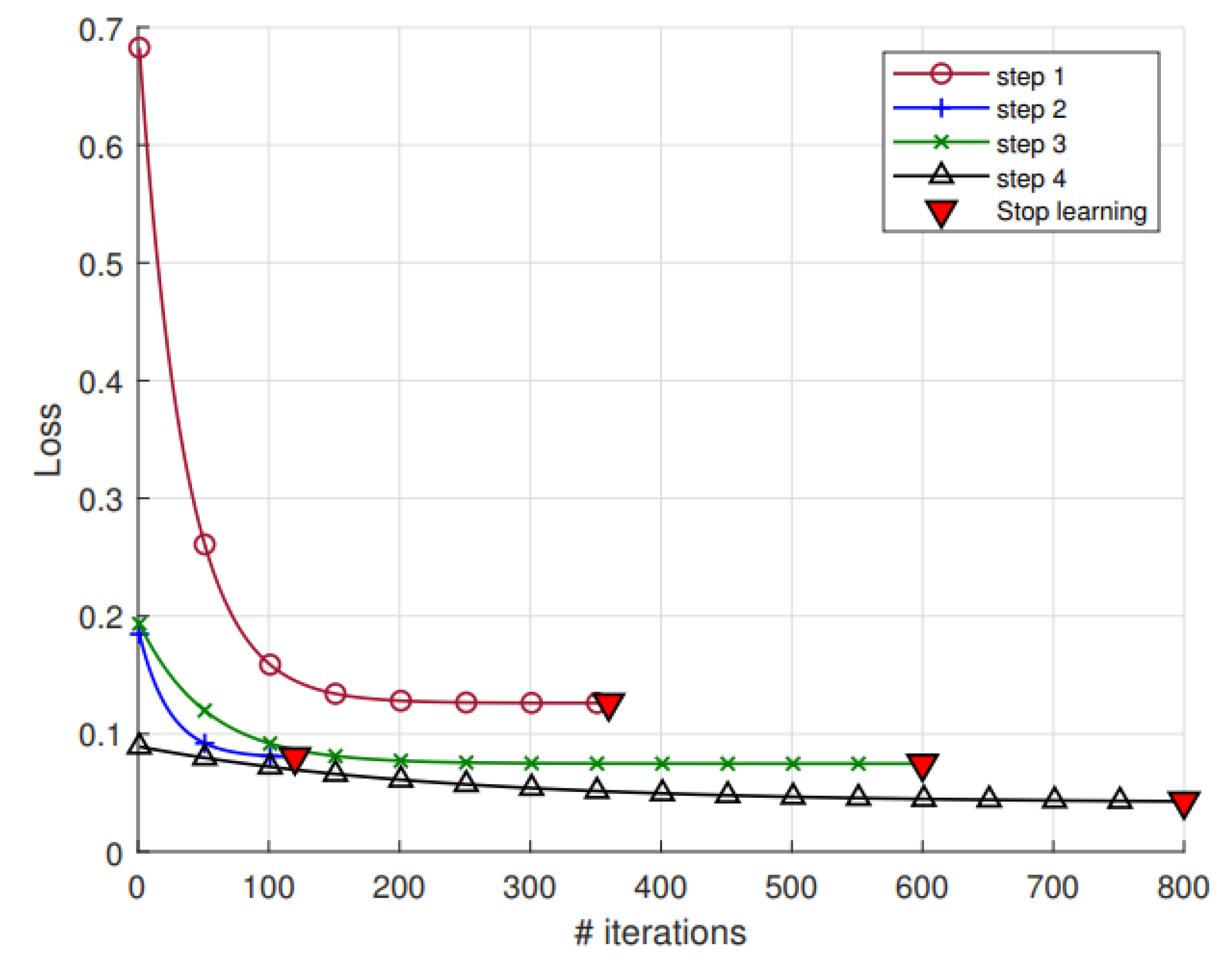
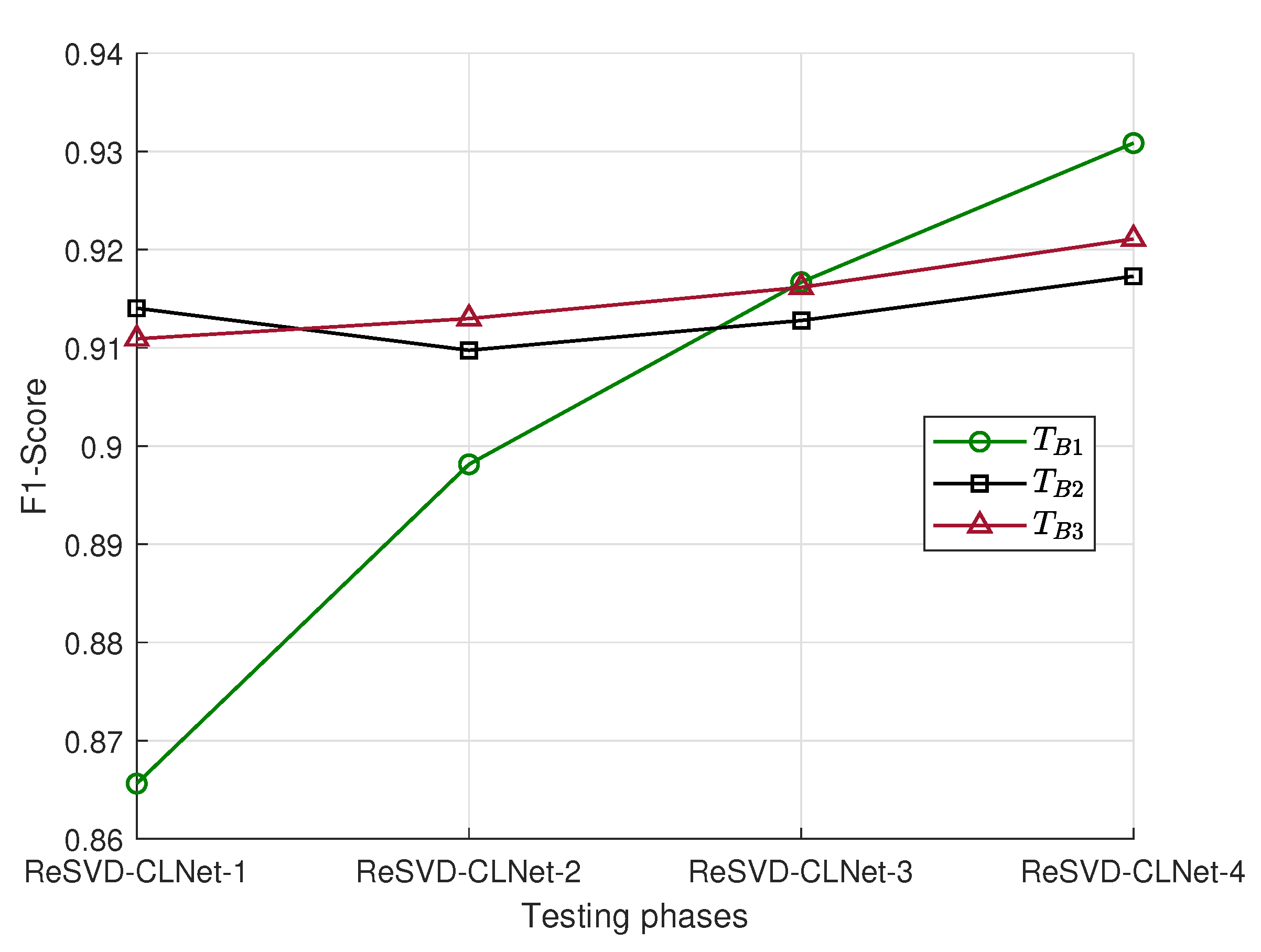

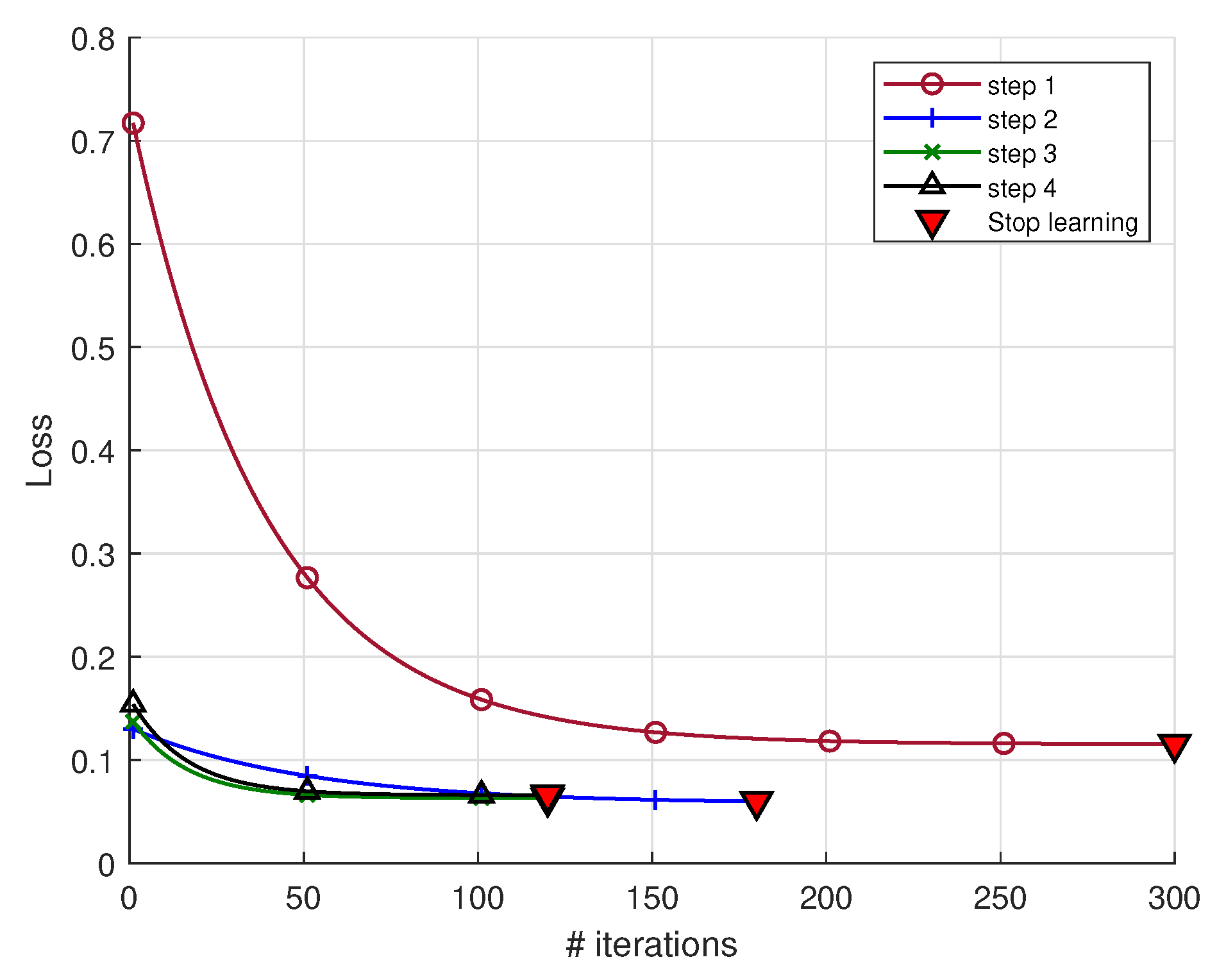
| Class | Accuracy | Recall | F1-Score |
|---|---|---|---|
| Healthy state | 0.998 | 0.935 | 0.965 |
| Stabilized wear | 0.836 | 0.959 | 0.893 |
| Progressive wear | 0.85 | 0.942 | 0.893 |
| Step | Accuracy Rate |
|---|---|
| 1 | 89.2% |
| 2 | 94.5% |
| 3 | 95.8% |
| 4 | 98.1 % |
| Parameter | |||||
|---|---|---|---|---|---|
| 1 | Mag. | 38.80 | 96.29 | 49.05 | 65.55 |
| Freq. | 62.69 | 20.00 | 55.07 | 63.57 | |
| 2 | Mag. | 69.87 | 100 | 16.39 | 34.07 |
| Freq. | 53.97 | 10.53 | 46.15 | 58.06 | |
| 3 | Mag. | 20.41 | 44.44 | 100 | 100 |
| Freq. | 86.42 | 46.81 | 79.52 | 37.76 |
| Step | Accuracy Rate |
|---|---|
| 1 | 94.7% |
| 2 | 96.6% |
| 3 | 91.3% |
| 4 | 93.2 % |
| Regimen | Training | Iteration Time (Minutes) | F1-Score | |
|---|---|---|---|---|
| OP-CL | 2.2 | 1 | 0.596 | |
| 2 | 0.550 | |||
| 3 | 0.567 | |||
| BS-CL | 3.6 | 1 | 0.829 | |
| 2 | 0.748 | |||
| 3 | 0.781 | |||
| No-CL | 4.1 | 1 | 0.297 | |
| 2 | 0.297 | |||
| 3 | 0.300 | |||
| ReSVD-CL | 2.5 | 1 | 0.870 | |
| 2 | 0.835 | |||
| 3 | 0.850 | |||
| ATT-1D CNN GRU | 0.8 | 1 | 0.644 | |
| 2 | 0.561 | |||
| 3 | 0.596 | |||
| AdaMTCN | 0.3 | 1 | 0.322 | |
| 2 | 0.317 | |||
| 3 | 0.322 | |||
| CNN-LSTM | 0.5 | 1 | 0.365 | |
| 2 | 0.361 | |||
| 3 | 0.370 |
Disclaimer/Publisher’s Note: The statements, opinions and data contained in all publications are solely those of the individual author(s) and contributor(s) and not of MDPI and/or the editor(s). MDPI and/or the editor(s) disclaim responsibility for any injury to people or property resulting from any ideas, methods, instructions or products referred to in the content. |
© 2025 by the authors. Licensee MDPI, Basel, Switzerland. This article is an open access article distributed under the terms and conditions of the Creative Commons Attribution (CC BY) license (https://creativecommons.org/licenses/by/4.0/).
Share and Cite
Suhas, M.; Abisset-Chavanne, E.; Rey, P.-A. Curriculum Learning Framework for Fault Diagnosis in Electric Motor Systems Based on Recurrent Neural Networks. Appl. Sci. 2025, 15, 11532. https://doi.org/10.3390/app152111532
Suhas M, Abisset-Chavanne E, Rey P-A. Curriculum Learning Framework for Fault Diagnosis in Electric Motor Systems Based on Recurrent Neural Networks. Applied Sciences. 2025; 15(21):11532. https://doi.org/10.3390/app152111532
Chicago/Turabian StyleSuhas, Morgane, Emmanuelle Abisset-Chavanne, and Pierre-André Rey. 2025. "Curriculum Learning Framework for Fault Diagnosis in Electric Motor Systems Based on Recurrent Neural Networks" Applied Sciences 15, no. 21: 11532. https://doi.org/10.3390/app152111532
APA StyleSuhas, M., Abisset-Chavanne, E., & Rey, P.-A. (2025). Curriculum Learning Framework for Fault Diagnosis in Electric Motor Systems Based on Recurrent Neural Networks. Applied Sciences, 15(21), 11532. https://doi.org/10.3390/app152111532






